Getting Paid
• Forty-five (45) percent of small-business owners feel that their most significant problem getting paid is slow or late payment (45%). The next largest group (16%) says theirs is bounced or bad checks. Comparatively few note failure to be paid in full (6%) or bankruptcies (4%). Many appear not to have notable problems getting paid.
• Thirty-seven (37) percent of small-business owners say that they receive payment exclusively at the time of sale, delivery, or job completion. Thirty-four (34) percent never get paid at that time.
• Twenty-seven (27) percent operate exclusively by invoices that are due upon receipt and another 46 percent sometimes invoice in that manner. However, only about half ever engage in other credit-type arrangements such as special terms or installment credit. Twenty-three (23) percent receive payment from third-party payers, though only 8 percent do so frequently.
• The most common (53%) terms for customers receiving credit (including invoicing) is “net 30 days.” The second most common is “due upon receipt” (17%). Only six percent use installment arrangements and virtually none employ revolving charges.
• Invoiced customers on average pay in 29 days. However, 11 percent of them average 46 days or more. Invoiced third-party payers on average pay in 34 days.
• Sixty-three (63) percent of small-business owners charge neither a late fee nor interest on overdue balances. Moreover, 28 percent never turn over delinquent receivables to a collection agency. Of those who do, the largest share sends them to an agency when their collection capabilities have been exhausted. The second largest group turns them over after 90 days.
• About half of all small-business owners accept credit cards for payment. The primary reasons that small-business owners accept them are: their customers expect to be able to pay that way (95%), cards enlarge the market by allowing customers to pay from a distance more easily (79%), and cards improve cash flow (69%). The most common reason for not accepting credit cards is that such transactions are not common to the industry.
• Virtually all small-business owners accept checks (95%). However, just seven percent use a check verification service.
• Thirty-six (36) have incurred at least one loss in the last five years due to a bankruptcy. Of those who have incurred bankruptcy related losses, 58 percent report they have been impacted by just one or two of them over the last five years. More are impacted by business bankruptcies than personal bankruptcies.
• Small-business owners are most likely to maintain the firm’s financial records themselves (49%). Less frequently, these records are maintained by someone outside the firm, e.g., an accountant (20%), an employee (19%) or a family member (11%). Billing and collections typically are included in this responsibility.


